Uncategorized
Microblading Aftercare: When and How to Wash Your Eyebrows
Table of Contents
Microblading has become an increasingly popular solution for achieving fuller, more defined eyebrows. However, the aftercare process is crucial to ensuring the longevity and success of your microbladed brows. One of the most common questions clients have is, “When can I wash my eyebrows after microblading?” This article will provide a comprehensive guide on the proper aftercare regimen, including when it’s safe to cleanse your newly microbladed eyebrows.
Key Takeaways
- Proper aftercare is essential for the success of your microbladed eyebrows
- The healing process can take up to 4 weeks, with specific guidelines for washing during this time
- Using the right products and techniques when washing your microbladed brows is crucial
- Avoiding common mistakes during the healing phase can help prevent complications
- Regular touch-ups and maintenance are necessary to maintain the longevity of your microbladed eyebrows
Understanding Microblading
Microblading is a revolutionary semi-permanent eyebrow enhancement technique that has gained immense popularity in recent years. This innovative procedure involves the use of fine, hair-like needles to create the appearance of naturally fuller, more defined brows. Unlike traditional tattoos, microblading provides a more subtle and natural-looking result, making it a go-to choice for those seeking to enhance their facial features without the commitment of permanent makeup.
What is Microblading?
Microblading is a form of semi-permanent makeup that uses a specialized tool to implant pigment into the skin, creating the illusion of individual brow hairs. The process involves a skilled technician manually etching fine, feathery strokes that seamlessly blend with the client’s natural brow hairs, resulting in a beautiful, youthful, and enhanced appearance.
The Benefits of Microbladed Eyebrows
- Enhances facial features and frames the eyes
- Saves time on daily makeup routines
- Provides a long-lasting solution for sparse or uneven brows
- Delivers a natural, microbladed look that complements various face shapes and features
- Boosts self-confidence and self-esteem
With its ability to create the appearance of fuller, more defined brows, microblading has become a go-to solution for individuals seeking to enhance their natural beauty without the hassle of daily makeup application. Whether you’re looking to correct sparse or uneven brows or simply want to achieve a polished, effortless look, this semi-permanent eyebrow treatment offers a game-changing solution that can transform your appearance and boost your confidence.
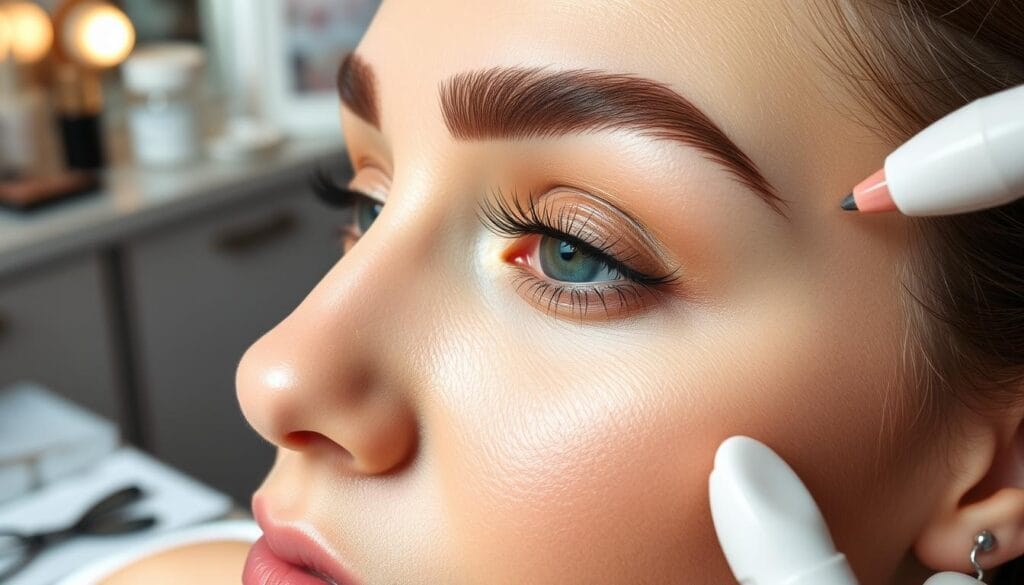
Importance of Proper Aftercare
Proper microblading aftercare is crucial for the optimal healing and longevity of your microbladed eyebrows. Following the recommended aftercare techniques provided by your microblading artist is essential to ensure a smooth microblading healing process and long-lasting results.
Neglecting the proper microblading maintenance can lead to a variety of issues, including poor pigment retention, infections, and even the premature fading of your microbladed eyebrows. By dedicating a bit of time and attention to your aftercare routine, you can maximize the investment you’ve made in your enhanced brows.
In the following sections, we’ll explore the various stages of the microblading healing process and provide you with a comprehensive guide on how to properly care for your new microbladed eyebrows. This will help you achieve the best possible outcome and enjoy your beautifully defined brows for years to come.
| Aftercare Technique | Importance |
|---|---|
| Gentle Cleansing | Helps prevent infection and maintain optimal healing |
| Moisturizing | Keeps the area hydrated and promotes faster healing |
| Sun Protection | Prevents fading and maintains the vibrancy of the pigment |
| Avoiding Irritants | Minimizes the risk of complications and ensures proper healing |
By following the recommended microblading aftercare guidelines, you can ensure a successful microblading healing process and enjoy the long-lasting benefits of your beautifully enhanced eyebrows.
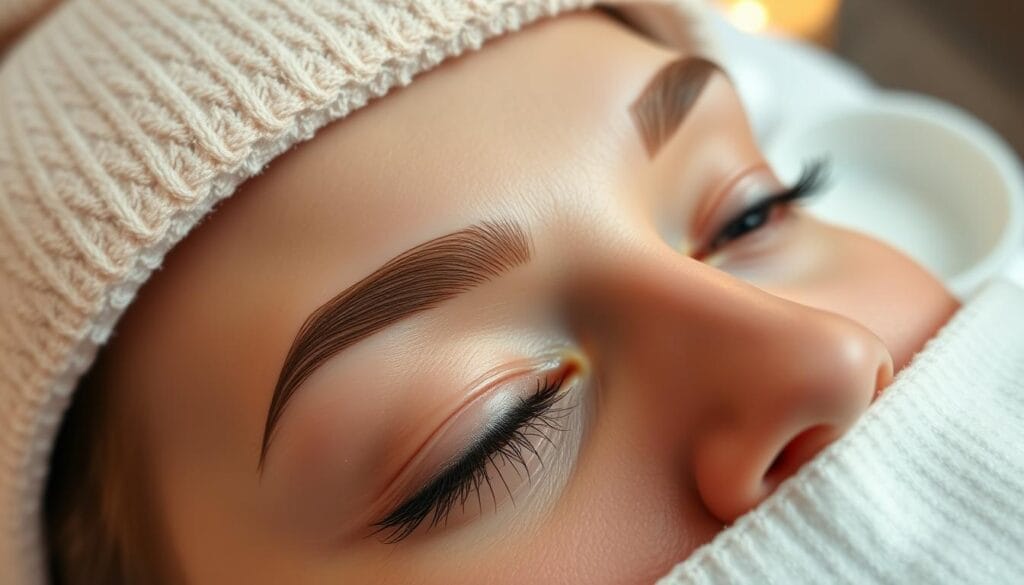
The Healing Process After Microblading
The microblading healing process is a crucial step in achieving long-lasting, natural-looking eyebrows. Understanding the different stages of healing and the factors that can affect it can help you better manage your expectations and ensure a smooth recovery.
Stages of Healing
The microblading healing process typically follows a predictable pattern:
- Initial redness and swelling: Immediately after the procedure, your eyebrows may appear red and swollen. This is a normal reaction as your skin adjusts to the new pigment.
- Scabbing and flaking: Over the next few days, small scabs will form as the skin heals. These will eventually flake off, revealing the new eyebrow shape underneath.
- Color fading and settling: During the healing process, the initial color of the microblading may appear darker or more vibrant. As the skin heals, the color will gradually fade and settle into its final, natural-looking shade.
- Final result: After about 4-6 weeks, your microbladed eyebrows will have fully healed, and the color will be set. This is the final result you can expect to enjoy for the duration of your microblading.
Factors Affecting Healing Time
While the general healing timeline is predictable, several factors can influence how long it takes for your microbladed eyebrows to fully heal:
- Skin type: Those with oily or acne-prone skin may experience a longer healing process.
- Age: Younger clients typically heal faster than older clients, as their skin has a higher cellular turnover rate.
- Aftercare practices: Proper aftercare, such as following the recommended cleaning and moisturizing routine, can significantly impact the healing timeline.
- Overall health: Factors like stress, diet, and lifestyle can also affect the body’s natural healing process.
By understanding the stages of microblading healing and the various factors that can influence it, you can better prepare for and manage your recovery, ensuring your eyebrows heal beautifully and last for years to come.
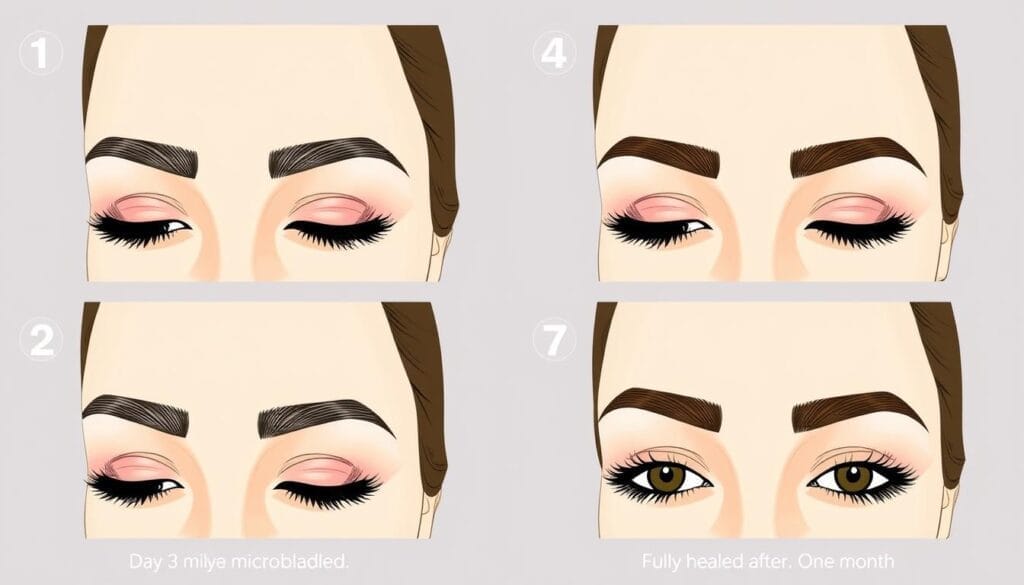
When Can I Wash My Eyebrows After Microblading?
Proper aftercare is crucial for ensuring the longevity and success of your microbladed eyebrows. One of the most common questions asked by clients is, “When can I wash my eyebrows after microblading?” The answer to this question is essential for maintaining the integrity of your new brows and allowing the healing process to progress smoothly.
According to microblading experts, it’s generally recommended to avoid washing your eyebrows for the first 7-10 days after the procedure. This initial waiting period is crucial for allowing the skin to heal and the pigment to set properly. Washing too soon can disrupt the healing process and potentially cause the pigment to fade prematurely.
During the first week, it’s best to gently blot the brow area with a clean tissue or cloth, avoiding any direct water contact. This gentle approach helps to keep the area clean while avoiding disruption to the delicate microbladed strokes.
- After the initial 7-10 day waiting period, you can begin to lightly wash your eyebrows using a mild, fragrance-free cleanser and lukewarm water.
- When washing, be sure to use a gentle, circular motion and avoid scrubbing or applying too much pressure.
- Pat the area dry with a clean, soft towel, and avoid exposing the brows to excessive heat or moisture until they are fully healed.
It’s important to follow the specific microblading washing guidelines provided by your artist, as the recommended timeline may vary depending on individual healing factors. By adhering to the proper washing schedule, you can help ensure the longevity and optimal results of your microbladed eyebrows.
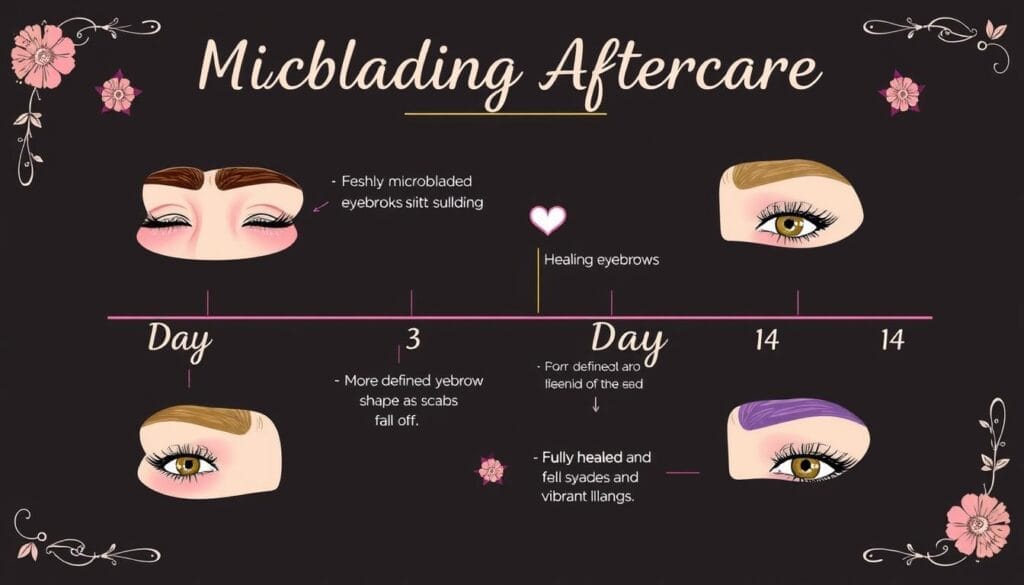
Remember, the healing process can take several weeks, so it’s essential to be patient and diligent with your aftercare routine. By following the recommended guidelines, you can maintain the beautiful, natural-looking eyebrows you’ve invested in through the microblading procedure.
Microblading Aftercare Instructions
Proper aftercare is crucial for ensuring your microbladed eyebrows heal properly and maintain their desired appearance. Following the right microblading aftercare instructions can make all the difference in the world. Let’s explore the essential dos and don’ts to keep in mind after your microblading treatment.
Microblading Aftercare Dos
- Gently cleanse the microbladed area twice a day with a mild, fragrance-free cleanser and lukewarm water.
- Apply a thin layer of the recommended aftercare ointment or balm to keep the area moisturized and promote healing.
- Avoid direct water exposure, such as swimming, showering, or washing your face, for the first 7-10 days.
- Protect your eyebrows from direct sunlight by wearing a hat or using a sunscreen with an SPF of 30 or higher.
- Attend all scheduled follow-up appointments with your microblading artist to ensure proper healing and touch-ups, if needed.
Microblading Aftercare Don’ts
- Don’t pick, scratch, or peel the scabs that may form, as this can lead to scarring and loss of pigment.
- Avoid using makeup, lotions, or any other products on the microbladed area during the initial healing phase.
- Steer clear of activities that may cause excess sweating, such as intense exercise, for the first week.
- Don’t expose your eyebrows to saunas, steam rooms, or extreme heat, as this can affect the healing process.
- Refrain from using retinol or exfoliating products around the microbladed area, as they can fade the pigment.
By following these microblading aftercare dos and don’ts, you can ensure your eyebrows heal beautifully and the results last for as long as possible. Remember, consistency is key when it comes to proper aftercare. If you have any concerns or questions, don’t hesitate to consult your microblading artist.

Washing Your Microbladed Eyebrows
Now that the recommended waiting period has passed, it’s time to learn the proper technique for washing your microbladed eyebrows. Maintaining a gentle, consistent cleansing routine is crucial to ensure the longevity and optimal results of your microblading procedure.
Proper Technique
When washing your microbladed eyebrows, it’s essential to use a gentle, fragrance-free cleanser and lukewarm water. Avoid using hot water, as it can disrupt the healing process and cause irritation. Here’s a step-by-step guide to properly wash your microbladed eyebrows:
- Start by gently patting the area around your eyebrows with a clean, soft towel to remove any excess oil or debris.
- Apply a small amount of the recommended cleanser onto your fingertips and lightly massage it into the microbladed area, using circular motions.
- Rinse the area with lukewarm water, being careful not to rub or scrub the eyebrows.
- Gently pat the area dry with a clean, soft towel, making sure not to wipe or rub the eyebrows.
It’s important to avoid using any harsh scrubbing motions or exfoliating products, as these can disrupt the delicate healing process and compromise the longevity of your microbladed eyebrows.
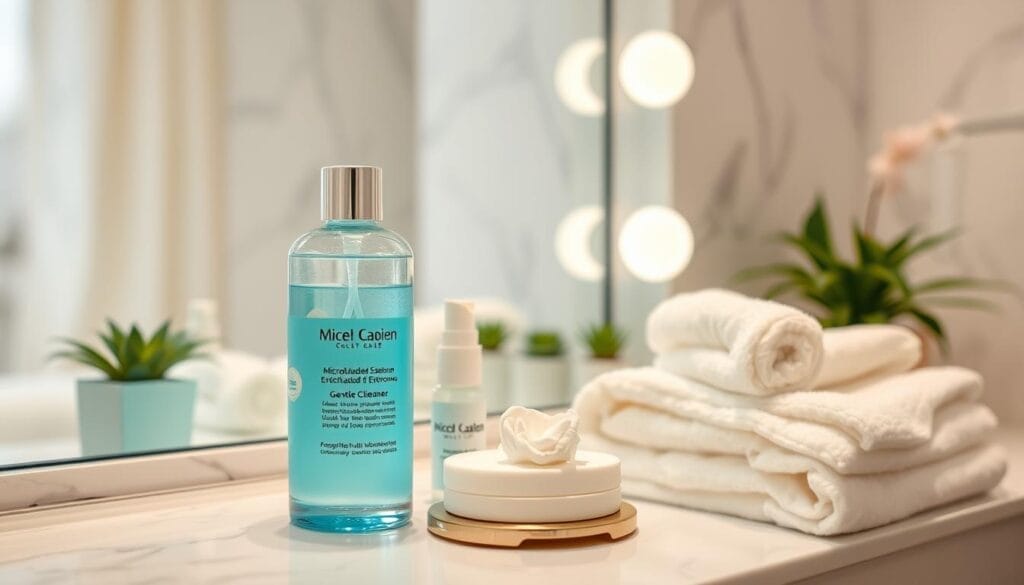
Following this gentle cleansing routine will help maintain the desired shape and color of your microbladed eyebrows, while also reducing the risk of any complications during the healing phase.
Products to Use for Microbladed Eyebrows
Maintaining the health and longevity of your microbladed eyebrows requires the use of specialized products. Choosing the right microblading approved products, best products for microbladed eyebrows, and recommended microblading aftercare products is crucial for ensuring optimal results and a seamless microblading skincare routine.
After your microblading procedure, it’s important to use a gentle, fragrance-free cleanser to keep the area clean and promote healing. Look for products that are specifically formulated for use on microbladed skin, as they are designed to be non-irritating and pH-balanced.
In addition to a suitable cleanser, a high-quality moisturizer is essential for maintaining the health and appearance of your microbladed eyebrows. Opt for a nourishing, hydrating formula that contains ingredients like hyaluronic acid, ceramides, and vitamins to support the skin’s natural barrier and prevent dryness.
For the first few days after your microblading treatment, your artist may recommend the use of a soothing ointment to help protect the delicate skin and facilitate the healing process. These specialized ointments are designed to create a barrier while allowing the skin to breathe and regenerate.
| Product | Purpose | Recommendation |
|---|---|---|
| Gentle Cleanser | Cleansing and promoting healing | Microblading-approved, fragrance-free formula |
| Moisturizer | Hydrating and nourishing the skin | Hyaluronic acid, ceramides, and vitamin-rich formula |
| Ointment | Protecting and facilitating healing | Specialized, microblading-specific ointment |
By incorporating these microblading approved products, best products for microbladed eyebrows, and recommended microblading aftercare products into your daily routine, you can ensure the longevity and health of your microblading skincare and enjoy your stunning, natural-looking eyebrows for years to come.
Avoiding Common Mistakes
Microblading is a semi-permanent cosmetic procedure that can dramatically enhance the appearance of your eyebrows. However, the aftercare process is crucial for achieving optimal results. Unfortunately, many people make common mistakes that can compromise the healing process and the longevity of their microbladed brows.
One of the most frequent common microblading mistakes is over-washing the treated area. While it’s important to keep the brows clean, excessive washing can strip the skin of its natural oils, leading to dryness, irritation, and even infection. Another common microblading aftercare error is using the wrong products, such as harsh cleansers or abrasive scrubs, which can damage the delicate skin.
Another mistake to avoid is picking at the scabs that form during the healing process. This can disrupt the pigment deposition and result in uneven or patchy brows. Similarly, what not to do after microblading includes exposing the treated area to excessive sun, water, or sweat, as this can cause the pigment to fade prematurely.
To ensure a successful microblading troubleshooting experience, it’s crucial to follow the aftercare instructions provided by your microblading artist to the letter. This includes gently cleaning the brows, applying the recommended ointments or creams, and protecting the area from external factors that could interfere with the healing process.
“The key to a flawless microblading result is proper aftercare. Neglecting this crucial step can undo all the hard work put into your beautiful new brows.”
By avoiding these common mistakes and diligently following the recommended aftercare routine, you can maximize the longevity and natural appearance of your microbladed eyebrows. Remember, patience and attention to detail are essential for achieving the best possible outcome.
In the next section, we’ll explore the signs of infection or complications that may arise and how to address them promptly.
Signs of Infection or Complications
Microblading is a semi-permanent cosmetic procedure that enhances the appearance of eyebrows. While the process is generally safe, it’s essential to be aware of potential microblading infection symptoms and microblading complications that may arise during the healing process.
One of the most critical signs to look out for is excessive redness, swelling, or pus around the treated area. These could be indicators of an infection that requires prompt medical attention. Additionally, if you experience persistent pain, fever, or unusual discharge, it’s crucial to see a doctor after microblading as soon as possible.
Other potential microblading aftercare issues include uneven pigment distribution, blotchy appearance, or premature fading of the brows. These complications may be the result of improper aftercare or individual skin reactions to the pigment used.
| Symptom | Potential Cause | Action to Take |
|---|---|---|
| Excessive redness, swelling, or pus | Infection | Seek medical attention immediately |
| Persistent pain, fever, or unusual discharge | Infection | Seek medical attention immediately |
| Uneven pigment distribution, blotchy appearance, or premature fading | Improper aftercare or individual skin reaction | Consult your microblading artist for guidance |
It’s essential to follow the recommended microblading aftercare instructions carefully to minimize the risk of complications. If you experience any concerning symptoms, don’t hesitate to seek medical attention or consult your microblading artist for advice.
Microblading Touch-Ups and Maintenance
Microblading is a semi-permanent cosmetic procedure that enhances the appearance of your eyebrows. While the results can be stunning, maintaining your microbladed eyebrows requires regular touch-ups and diligent care. In this section, we’ll explore the importance of scheduled touch-ups and share valuable tips for keeping your microbladed eyebrows looking their best for the long haul.
Scheduled Touch-Ups
Microblading is not a one-and-done solution. As your skin naturally sheds and the pigment fades over time, it’s essential to schedule periodic touch-ups to maintain the desired look. Generally, most people require touch-ups every 6 to 12 months to keep their microbladed eyebrows looking sharp and defined.
Maintaining Microbladed Eyebrows
To ensure the longevity of your microbladed eyebrows, it’s crucial to follow a few key steps in your daily routine:
- Gently cleanse the area with a mild, fragrance-free cleanser to remove any oil, dirt, or makeup buildup.
- Apply a thin layer of the recommended aftercare ointment or moisturizer to keep the skin hydrated and prevent premature fading.
- Avoid excessive sun exposure, as UV rays can cause the pigment to fade more quickly.
- Steer clear of harsh scrubbing, exfoliating, or using makeup removers that could compromise the integrity of the microbladed area.
Microblading Longevity
With proper care and maintenance, your microbladed eyebrows can last for several years. However, the longevity of the results can vary depending on factors like skin type, lifestyle, and individual healing processes. Regular touch-ups are essential to ensure your eyebrows remain vibrant and natural-looking for the long haul.
| Maintenance Frequency | Skin Type | Longevity |
|---|---|---|
| Every 6-12 months | Oily | 1-2 years |
| Every 12-18 months | Normal | 2-3 years |
| Every 18-24 months | Dry | 3-4 years |
Remember, consistent microblading touch-ups and diligent maintenance of microbladed eyebrows are key to ensuring your microblading upkeep and microblading longevity for years to come.
Tips for Long-Lasting Microbladed Eyebrows
To ensure your microbladed eyebrows stay looking their best for as long as possible, it’s important to follow a consistent maintenance routine and avoid certain habits that can compromise the longevity of your results. Here are some practical tips to help you maintain your microbladed brows:
- Protect Your Brows from Sun Exposure – Always apply a broad-spectrum sunscreen to your eyebrows when going outdoors. UV rays can fade the pigment and cause premature fading of your microblading.
- Avoid Certain Skincare Products – Steer clear of products containing acids, retinoids, or other harsh ingredients that can prematurely lighten your microbladed brows. Stick to gentle, fragrance-free cleansers and moisturizers.
- Maintain a Regular Touch-Up Schedule – Plan to get touch-up appointments every 6-12 months to keep your microbladed eyebrows looking their best. This helps reinforce the pigment and ensure a cohesive, natural appearance.
By prioritizing sun protection, using the right skincare products, and scheduling regular touch-ups, you can maximize the longevity of your microbladed eyebrows and enjoy their transformative effects for years to come.
| Tip | Description |
|---|---|
| Sun Protection | Always apply a broad-spectrum sunscreen to your eyebrows when going outdoors. UV rays can fade the pigment and cause premature fading of your microblading. |
| Avoid Harsh Products | Steer clear of products containing acids, retinoids, or other harsh ingredients that can prematurely lighten your microbladed brows. Stick to gentle, fragrance-free cleansers and moisturizers. |
| Regular Touch-Ups | Plan to get touch-up appointments every 6-12 months to keep your microbladed eyebrows looking their best. This helps reinforce the pigment and ensure a cohesive, natural appearance. |
“Maintaining your microbladed eyebrows is all about being proactive and consistent. With the right care, you can enjoy the benefits of your enhanced brows for years to come.”
Conclusion
In summary, proper aftercare is essential for achieving long-lasting, natural-looking results from your microblading procedure. By understanding the importance of following the recommended instructions, including when it’s safe to start washing your microbladed eyebrows, you can ensure a smooth healing process and maintain your beautiful, enhanced brows.
The key takeaways for washing your microbladed eyebrows include waiting at least 10 days before gently cleansing the area, using a mild, fragrance-free soap, and avoiding excessive water exposure. By adhering to these guidelines and incorporating the appropriate products and techniques, you can protect your investment and enjoy your stunning, long-lasting microbladed eyebrows.
Proper microblading maintenance is crucial for maintaining the vibrancy and precision of your enhanced brows. Regular touch-ups, moisturizing, and sun protection will help ensure your microbladed eyebrows remain looking their best for years to come. Remember, by prioritizing the summary of microblading aftercare, you’ll be well on your way to achieving the natural, effortless brow look you’ve always desired.

